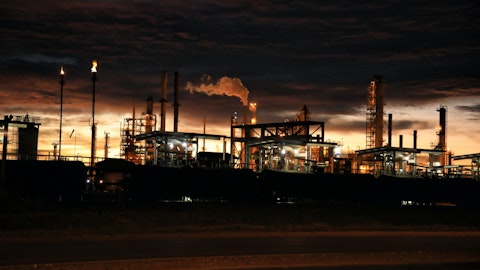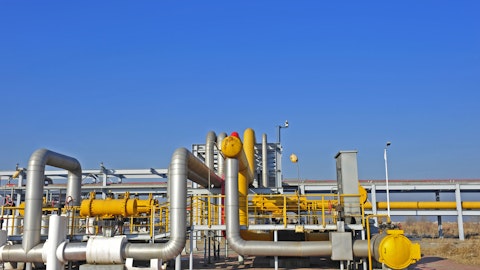The answer is if there are opportunities out there, it’s in our ethos and DNA to capture markets. We’ve got the broad assets and a company with people that focus on this every day. And so, if there are opportunities out there, we’ll capture but it’s very difficult to predict exactly where they happen. And again, this year’s budget is based on a modest amount of market opportunities and that’s frankly, why we move towards the range to give people kind of a range of thought of what those might be. I hope that helps.
Operator: Our next question comes from Jean Salisbury with Bernstein. Your line is now open.
Jean Salisbury: Can you talk through the puts and takes of TMX starting up on Plains’ various assets in Canada, your Canada crude pipelines flows to Cushing, et cetera?
Jeremy Goebel: Hi, Jean. Good morning. It’s Jeremy. It’s a function of time. It’s not just linear, but at startup you would imagine there’d be less market based opportunities, but there’ll be the opportunity for more production growth in the basin. It will offset some current flows like rail from the Williston or exports of heavy from the Gulf Coast first. And then you’ll have replacement of — and in our opinion, you’ll have replacement of production growth in Canada. So in that initial period, there’ll be less market based opportunities, depending upon the flows that go west. If its lighter barrels or heavy barrels that could impact flows to the Midwest of basin barrels or other light barrels. So there are opportunities, we’re going to have to wait for it to start up and transition into full capacity that can be reached and what those flows will impact all those components.
But we have a flexible system. We’re touching all parts of that value chain. So if it’s fee-based growth on the gathering systems, we’re excited about that, as the base and titans again, and market opportunities come back, that’s fine for us too, but we’ll be there wherever the opportunities present themselves.
Jean Salisbury: Okay. Thank you for that and just a kind of similar follow-up. Some Bakken contracts began to roll this year on HH and DAPL going out of the Bakken. Do you anticipate any major change in how much Bakken crude makes its way kind of the westbound route down to Saddlehorn or the Cushing market or other things that could impact plans as EBITDA?
Jeremy Goebel: Sure. So, there’s a few things that impacted. There’s certain gathering systems that feeds out and certain that feed into the DAPL system. But outside of those jump ball barrels, I think it’ll just be competitive between the groups that head South and the groups that head to the Gulf Coast in [Toka]. So, we’re there patient, we talk to our customers. Saddlehorn largely full from DJ Basin, it has some movements from [Indiscernible] and those opportunities are presenting themselves. And so, we’ll continue to work with shippers to bring them south, if it makes sense, but there should be plenty barrels to go around in that area.
Operator: Our next question comes from Neel Mitra with Bank of America. Your line is now open.
Neel Mitra: I wanted to touch on the 90% of NGL fracs spreads that are hedged for ‘24. Obviously, product spreads have trended up lately. I was wondering, if you’re able to catch some of that with the incremental hedges you put on, and how are you looking at perhaps hedging more than usual and may be going up to a 100% if you’re content with this spread environment right now?
Jeremy Goebel: Neel, first thing is really backwardated and until natural gas prices tanked a few weeks ago, it was substantially lower. So, this is relatively new and it is much higher in the front. I think 2025 is $0.56, $0.57 and prompt could be at $0.80. So that backwardation prevents a lot of forward hedging. Our hedges are consistent with what Al said in the mid 60s at roughly 90%. And what you could say is that the hedging profile for us is somewhat consistent with the forward market. So, we’re higher hedge than the front and lower hedge than the back end of the year, if that’s helpful.
Neel Mitra: Okay. And then second question, Jeremy. Maybe just if there’s away to kind of bridge where the Midland MEH spread is right now for ‘25 and where you’re looking to contract? And how we should look at it on a contract basis versus a spread basis when you’re signing up these contracts?
Willie Chiang: What I would tell you, Neel is, most of these contracts are for the latter half of ‘25 and forward. So, we’re not really looking at the ‘25 market, we’re looking more what is the constructive long-term rate to ship barrels from the Permian to the Gulf Coast. And so that’s between us and the shippers, but we’re having constructive dialogue and we’re less worried about ‘24 and ‘25 and more what the long term rate is after the contract’s rolled.
Neel Mitra: And when you talk to your counterparties, are these three to five year contracts typically or are you looking longer?
Willie Chiang: Neel, what I would suggest is we’ll give you an update later in the year and give you more information.
Operator: Our next question comes from Jeremy Tonet with JP Morgan Securities. Your line is now open.
Unidentified Analyst: This is [indiscernible] on for Jeremy. For my first one, I just wanted to ask on more color on the 2024 intra-basin and long-haul volumes. It looks like the ‘24 guide is down versus THE 4Q ‘23 rates. So if you could discuss drivers there? And as maybe a second part to that question, do the long-haul shipments include the 50,000 barrel per day shipments that have already been prepaid?
Willie Chiang: I’m going to go back and look for your question here. So you said intra-basin volumes on the guide verse long-haul. So, I’m looking at Q4 of long-haul and intra-basin and then for next year. I would say, there’s probably some noise in that Q4 had a bunch of flush production. Some of that volume with Wink-to-Webster connecting in it Wink. Some volume will go in that direction, which is actually a positive because those are shorter-haul tariffs and that leads for integrated movements on our gathering system. So, I’d say this is all consistent with our guidance and constructive for volume growth out to the Delaware Basin. And then the long-haul side, I believe I answered that question earlier, it was just a surge-in based in production in the fourth quarter and more normalized for the rest of the year.
Unidentified Analyst: And then for the second one, it looks like Plains is approaching the long-term distribution coverage target. So just could you walk through how you guys think about distribution progression from here? Maybe versus step up and then flattening out or a more rate-able moderate step up in the future.
Al Swanson: Well, I think, our current guidance for this year shows 190% coverage. So, we’ve got a bit to go our stated approach will be $0.15 a year until we hit the 160%. And then DCF growth will drive future increases there. So, we haven’t provided guidance for ‘25 or ‘26 yet. But yes, with this 19% or 20% increase we just did, we’re still at 190% coverage.
Operator: Our next question comes from Sunil Sibal with Seaport Global. Your line is now open.
Sunil Sibal: So, I just want you to dwell a little bit on your gathering volumes. Could you give us a sense of your gathering volumes in Permian, roughly, what percentage of that comes from your dedicated acreage versus day credit where you may be competing for volumes?
Willie Chiang: Hi, Sunil. This is Willie. I don’t know if you were on earlier, but the overall gathering volume increases are 275,000 barrels a day, 150,000 of it’s from bolt-ons that we did. The remainder of the growth, $125,000 is really all Delaware Basin growth.
Sunil Sibal: No, I was actually referring to your current gathering volumes. I was curious in Permian, is there a good sense of what all comes from your dedicated acreages in Permian versus the acreage is where you may be completing for those gathering volumes.
Al Swanson: Sunil, I would say the vast majority is associated with the 4.4 million acres that Willie referenced in his script. That is dedicated.
Sunil Sibal: Understood. And then on the M&A front, it seems like you divested some assets in 2023. Could you give us a sense of from an opportunistic M&A perspective, where do you see the most value either basin-wise or asset-wise?
Willie Chiang: Sunil, that’s probably something we’re not going to comment on, all the what if, I can assure you that we look at, we run models on all kinds of different things, we look at all the different assets and opportunities to create value for our unitholders. And on the same token, we look to optimize our own asset base as we’ve proven over the last number of years. It’s a dynamic activity that happens every day. It’s really hard to focus on valuations in different basins. We’ll have to maybe we can follow up with you on the offline and see if we can answer your question a little bit better.
Operator: Our next question comes from Neal Dingmann with Truist Securities. Your line is now open.




